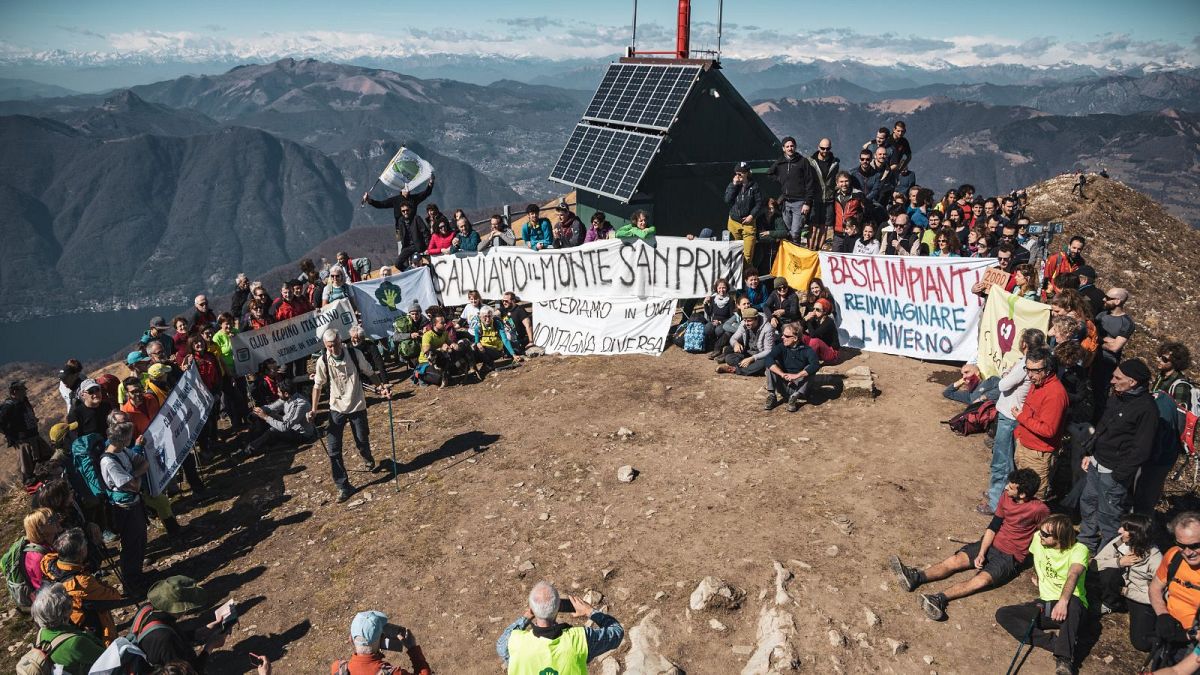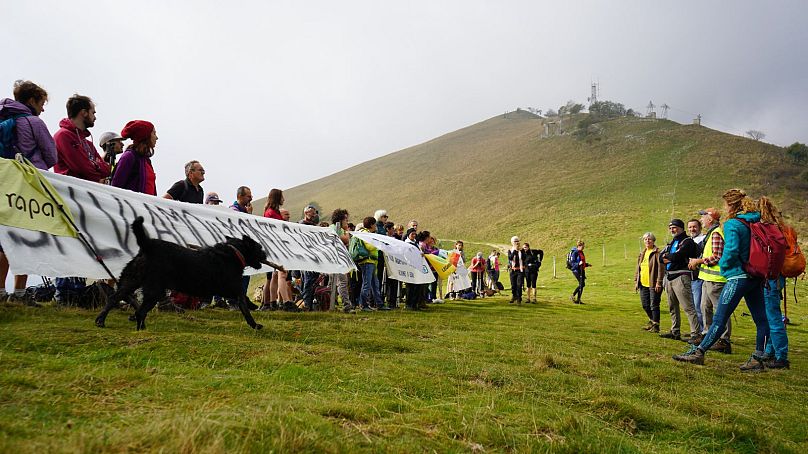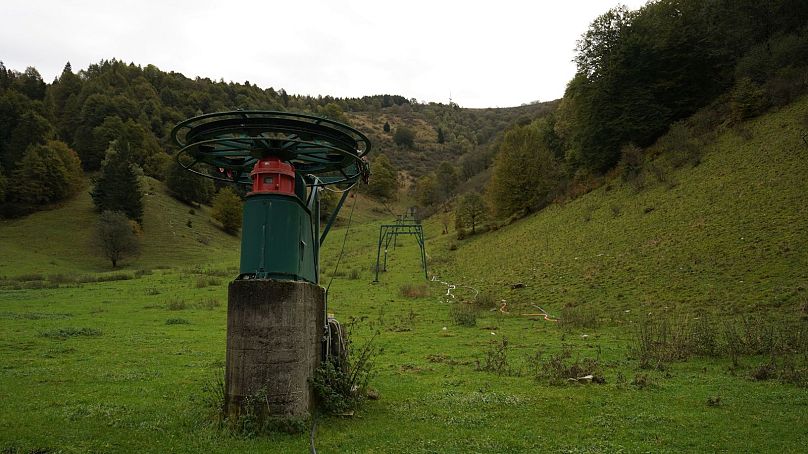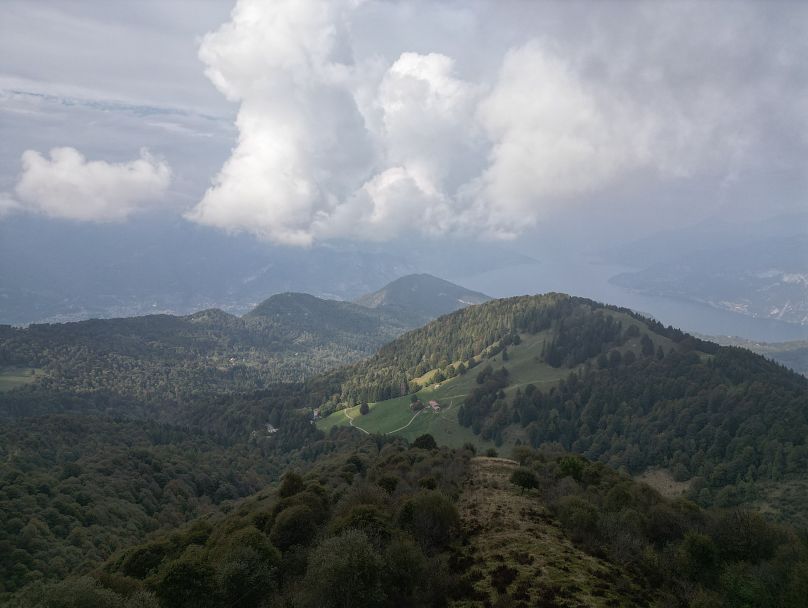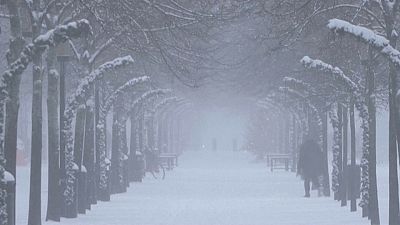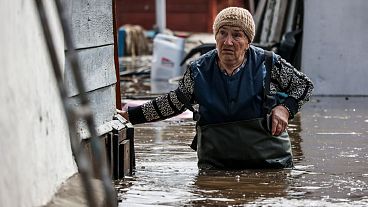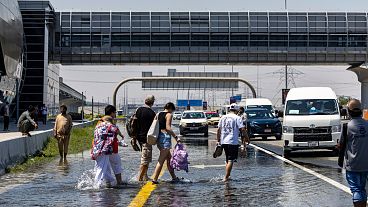Activists in the Alps argue there’s no point in spending public money on snowless resorts. Instead, they want investment in sustainable mountain tourism.
On a cloudy October morning, local activists walked to the top of Monte San Primo, in northern Italy, to oppose the renovation of a decommissioned ski resort.
With a summit at 1,685 metres in the Italian Alps, just an hour from Milan, Monte San Primo offers a panorama over iconic Lake Como.
But the beautiful landscape is littered with decaying ski infrastructure. Three ski lifts, which haven’t been used for years, stand out on the mountainside. Next to them, a snow cannon is surrounded by growing vegetation.
At the same time as the Monte San Primo protest, demonstrations were staged simultaneously across the Alps and the Apennines. All opposing other short-sighted and invasive investments in Italy at a time when the climate crisis casts doubt on the sustainability of winter sports.
What do the activists want?
The activists are protesting the use of public funds to renovate the old, low-altitude ski equipment. They argue it will all be useless soon anyway, as global temperatures rise.
Local authorities plan to spend €5 million on new lifts, a bob and tubing area, a reservoir for artificial snowmaking and a bigger car park.
“It’s out of date. Even in terms of profitability, these lifts don’t make sense anymore,” says Roberto Fumagalli, President of the Coordinamento Salviamo il Monte San Primo or the ‘Committee to save Monte San Primo’. It brings together 33 grassroots organisations pushing to stop the project.
The activists want the old ski lifts to be dismantled. They believe the funds would be better used to clean up the hiking trails, improve public transport and maintain the surrounding woodland, all while supporting slow forms of tourism.
Facing a future of warmer, snowless mountains
Many ski resorts in Italy were built in the 1960s and 70s. San Primo became popular a little earlier, in the late fifties, but as the years passed by it fell out of favour. They have barely been any skiers here since 2013.
“Here we are just above 1,000 metres. Even if you use artificial snow, it takes one sunny day to melt it,” says Antonio Bertelé, a protester who learned to ski in the seventies on the slopes of San Primo. “It’s just absurd to invest in ski tourism here.”
In Italy, there are 249 decommissioned ski resorts, and 138 are temporarily closed. 84 are open only intermittently and 181 are surviving through public funding, according to a survey from Legambiente, a leading Italian environmental NGO.
“High altitude facilities will live longer, but they must diversify anyway. But those at a low altitude simply live in the illusion of a great snowfall,” says Vanda Bonardo, head of the Alps division of Legambiente.
Last winter, in many Alpine ski resorts tourists skied on streaks of artificial snow cutting through the grass. According to the Copernicus Climate Change Service, 2022 was Europe's second warmest year on record. Data from CNR-ISAC showed that last year was the hottest and driest in Italy since 1800.
“If you look at the historical series since 1850, the general trend is towards an increase in temperature and a decrease in snowfall. There are more and more warm years that break the records of previous years,” says Antonella Senese, a glaciologist at the University of Milan.
In the Alps, temperatures increased more than double compared to the average. According to Legambiente, out of 224 mountain municipalities located in or near ski resorts, 22 experienced an increase of 3 degrees or more between 1961 and 2018.
As global heating intensifies, the permanence of snow on the soil is also impacted. Between 2000 and 2019, snow cover patterns in the greater Alpine region above 3,000 meters showed a significant reduction with an average of minus 17 days per decade, Senese explains.
Artificial snow is not a solution
Mountain areas are intensively exploited to feed the ski industry. A few weeks ago, environmentalists staged a demonstration at Lago Bianco, an alpine lake located in a nature reserve, after bulldozers started drilling and digging around it to pump water for the snow cannons of the Santa Caterina di Valfurva ski resort.
In Italy, 90 per cent of slopes are covered with artificial snow. The percentage is much lower in other Alpine countries, with Austria using it for 70 per cent of its pistes and Switzerland and France respectively for 70 per cent and 50 per cent.
Artificial snowmaking involves building pipes and basins, impacting the environment, depleting water resources and adding on energy costs.
Sustainable tourism is the answer
Instead of exploiting mountains through ski tourism, some places have started investing in year-round tourism with snowshoeing, mountain biking, trekking, climbing, or cultural activities involving local food and traditions.
Valpelline, a valley in Valle d’Aosta, has no ski lifts. Instead tourists can enjoy family-run accommodation, huts, and activities where farmers, artisans, and hosts team up to promote responsible tourism immersed in nature, while respecting the local community.
Similarly in Piedmont, Valle Maira is an isolated valley that has long been off the radar of intensive tourism. The valley lacks ski infrastructure and, after years of depopulation, is flourishing thanks to sustainable practices.
“Sustainability has three core aspects: environmental, economic, and social,” says Raffaele Marini, president of the mountain environment protection commission at the Italian Alpine Club. “Winter tourism must head towards diversification, avoiding flow peaks concentrated in a few spaces and in a short time.”
But mitigation and adaptation are also required from tourists.
From the top of Monte San Primo, Fumagalli points to the area where the new lifts are planned. Then he looks at the lake and the mountains around him before enjoying his lunch after the long hike. “There is no need for hit-and-run tourism here,” he says.
